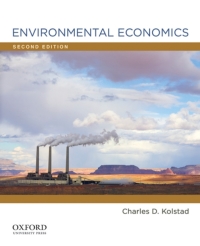Suppose the total cost of controlling the pollution in Bangkok is given by (T C=(3+) (r) q^{2})
Question:
Suppose the total cost of controlling the pollution in Bangkok is given by \(T C=(3+\) \(r) q^{2}\) where \(q\) is the amount of emissions controlled. Uncontrolled, there would be 2 units of emissions. Thus \(q=2-e\), where \(e\) is emissions. The variable \(r\) is unknown to the pollution control board. All they know is that it could take the value of either \(r=0\) or \(r=4\), and with equal likelihood. Marginal damage from emissions is given by \(M D(e)=4 e\).
a. Write the total cost of pollution control in terms of \(e\). Graph this total cost as a function of \(e\).
b. Graph the marginal damages from emissions and the expected value (i.e., average over the two possible \(r\) ) of the marginal savings from emissions. Be as accurate as you can.
c. What level of emission fee or emission permit should be chosen, not knowing what value \(r\) will take? Show your answer on the graph.
d. Suppose after you have set the fee or permit in part (b). it turns out that \(r=4\). Show the deadweight loss from the permit and fee, assuming these instruments cannot be changed. Which instrument appears to be better?
Step by Step Answer:





